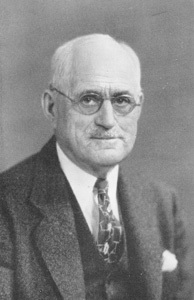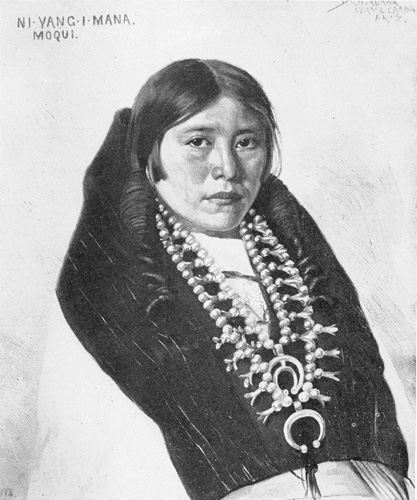With his artist's kit in a buckboard or a saddlebag, E. A. Burbank traveled the Indian country and painted so well that Charles F. Lummis wrote of him, "He is by odds the most successful thus far of all who have attempted Indian portraiture." That was during the period when the Apaches were running wild - but despite the bad reputation of the Apache tribesmen, Burbank painted portraits of nearly all their chieftains, including seven poses of Geronimo. The artist is now living in comparative retirement in San Francisco - but his work may be seen in many homes and trading posts all over the Southwest.

This picture of E. A. Burbank was
taken within the past two years.
He Painted
the Apaches
By RANDALL HENDERSON

Burbank's painting of Ni-Yang-I-Mana, once the belle of the
Hopi tribesmen. This was her wedding dress.
On the walls of the colorful living room of the veteran Indian trader Lorenzo Hubbell at Polacca, Arizona, I saw some remarkably life-like character studies of Navajo and Hopi tribesmen, done in crayon.
Lorenzo was showing me his collection of woven rugs and pottery and other native artifacts - select pieces of the finest craftsmanship from the Arizona reservations.
It was an interesting exhibit, but I kept returning to those sketches. They were the work of an artist with far more than usual skill in the portrayal of native character and costume. His name was penciled lightly in the corner.
It was "E. A. Burbank."
Since then, I have come across many of the Burbank sketches and paintings in the Indian country - at Gallup, Albuquerque, Grand Canyon, and in remote trading posts deep in the reservation.
Then one day shortly after the first number of Desert Magazine appeared in 1937, I received in my mail a note from E. A. Burbank - just a simple expression of approval for the new magazine of the desert Southwest. Since then many letters have been exchanged and while I have never met this artist personally, I have learned enough about his work to have a great admiration for his achievements. Much of my information came from an old copy of Charles F. Lummis' magazine The Land of Sunshine, out of print for many years.
Burbank was painting and sketching in the Indian region of the Southwest during the same period Lummis was delving into archaeology, and through his writings, trying to convince indifferent Americans that desert Indians were something more than mere untutored savages.
The Indians liked Burbank and trusted him. He painted seven portraits of Geronimo, three of Naiche, and his canvases included Mangus Colorado and practically all of the Apache leaders of that period. Of the Apaches, he says:
"Of all the 128 different Indian tribesmen who have posed for me, I found the Apaches the least superstitious, the most honest and friendly. When I made an appointment with an Apache, he always appeared at the time and place agreed upon."
Born in Harvard, Illinois, Burbank began his art training in the old Academy of Design in Chicago in 1874. He studied in Munich from 1886 to 1892. His uncle was Edward E. Ayer, first president of the Field Columbian museum, a trustee of the Newberry library and the owner of one of the finest private collections of Indian Americana in this country.
Through the interest of his uncle he turned westward to try character portraiture of the Indians, first in Oklahoma and then in the Sioux, Cheyenne and Nez Perce country. Eventually he reached the Southwest and traveled and worked among Apache, Navajo, Zuni, Hopi and other Pueblo tribesmen.
His first meeting with Charles F. Lummis was in Los Angeles. "I wanted to meet the writer and editor who had been so ably portraying the Indians of the Southwest," he said. "I called at his office on Broadway and was directed to his home along the Arroyo Seco. I had heard much of the unusual home he was building there. When I arrived there I saw a laboring man dressed in stone mason's clothing, and when I explained that I wanted to see Mr. Lummis he replied, 'I am Mr. Lummis.'
"I spent the greater part of the day with him, and cannot remember a more enjoyable or instructive conversation. He had bought several acres of land and was building a large house with his own hands. He was doing all the masonry and carpenter work, including the making of doors and windows."
Later, in a magazine story, Lummis wrote of Burbank:
"Without the least disparagement to the art of Brush, Farny, Remington and others ... it is entirely within bounds to say that no one rivals Burbank as an historical painter of Indians ... One of the reasons why Mr. Burbank can paint Indians lies back of his fingers, and was not learned in art school. He can not only see, but understand. They are to him not merely line and color, but human character. More ignorant people, who fancy that aborigines are not quite men and women, might be enlightened - if anything can enlighten them - by talk with this unassuming painter.
"Mr. Burbank has in general selected very characteristic types and his portraits are done with vigorous exactness. He neither extenuates nor sets down aught in malice. He neither idealizes nor blinks. From our personal point of view his pictures are harsh - not retouched as we demand of our artists to flatter us, but as uncompromising as a photograph done in strong sunlight.
"Popularly, this may give a mistaken impression, for many will forget that one chief reason why an Indian is so much more furrowed and ugly than we are is because he has no retoucher to make him pretty. But scientifically, this insistence upon the lines in which life indexes character, is very important.
"His work has historic truth and value for which we seek in vain, from Catlin down to date, for a parallel. As Lungren is doing the best and truest work yet done on the western arid landscapes and atmospheres, so Burbank is easily master of Indian faces."
All this was written many years ago. The man who wrote these lines about E. A. Burbank has been dead for many years, but the artist about whom they were written is still so vigorous that within recent years he toured Death Valley to do a series of drawings for a book about that region.
Mr. Burbank makes his home in San Francisco -- but his heart is still in the arid region where so much of the finest of his life's work has been done.